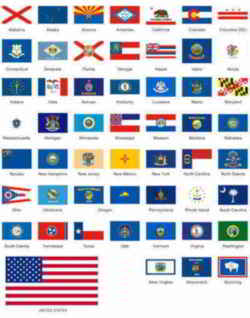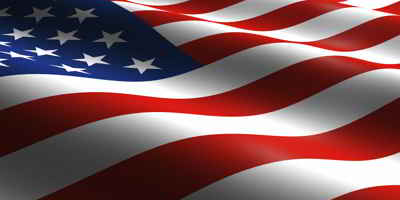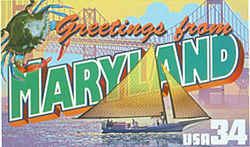Maryland State Flag
Adopted in 1904.
The state flag of Maryland was adopted in 1904 (Chapter 48, Acts of 1904).
Maryland's flag bears the arms of the Calvert and Crossland families. It is the only state flag in the United States to be based on English heraldry. (While the flag of Washington, D.C., is a representation of the coat of arms of the Washington family, Washington, D.C., is not a state.)
The Maryland State Flag
History of the Maryland Flag
Calvert was the family name of the Lords Baltimore who founded Maryland, and their colors of gold and black appear in the first and fourth quarters of the flag. At first, only the gold and black Calvert arms were associated with Maryland, being reintroduced in 1854. Crossland was the family of the mother of George Calvert, first Lord Baltimore. The red and white Crossland colors, with a cross bottony, appear in the second and third quarters, gained popularity during the American Civil War, during which Maryland remained with the Union despite many citizens' support for the Confederacy. Those Marylanders who supported the Confederacy, many of whom fought in the Army of Northern Virginia, adopted the Crossland banner, which was red and white with the bottony (trefoil) cross (seen as "secession colors"). The black and gold (yellow) colors with the chevron design of the Calvert family were used in the flags and devices of the Union regiments in the Army of the Potomac.
After the war, Marylanders who had fought on either side of the conflict returned to their state in need of reconciliation. The present design, which incorporates both of the coats of arms used by George Calvert, began appearing. At first, the Crossland coat of arms was put in the upper-left corner, but this was supposedly swapped with the Union's Calvert arms because of the Union victory.
The flag in its present form was first flown on October 11, 1880, in Baltimore, Maryland, at a parade marking the 150th anniversary of the founding of Baltimore. It also was flown October 25, 1888, at Gettysburg Battlefield for ceremonies dedicating monuments to Maryland regiments of the Army of the Potomac. However, it was not officially adopted as the state flag until 1904 (Chapter 48, Acts of 1904, effective March 9, 1904)
Design of Maryland Flag
The black and gold design on the flag is the coat of arms of the Calvert family. It was granted to George Calvert as a reward for his storming a fortification during a battle (the vertical bars approximate the bars of the palisade). The red and white design is the coat of arms of the Crossland family, the family of Calvert's mother, and features a cross bottony. Since George Calvert's mother was an heiress, he was entitled to use both coats of arms in his banner. It is one of only four US state flags that does not contain the color blue.
Legal description
Section 13-202 of the State Government Article of the Annotated Code of Maryland provides:
a) In general.- The State flag is quartered.
(b) First and fourth quarters.- The 1st and 4th quarters are paly of 6 pieces, or and sable, a bend dexter counterchanged. Thus, the 1st and 4th quarters consist of 6 vertical bars alternately gold and black with a diagonal band on which the colors are reversed.
(c) Second and third quarters.- The 2nd and 3rd, quarterly, are argent and gules, a cross bottony countersigned. Thus, the 2nd and 3rd quarters are a quartered field of red and white, charged with a Greek cross, its arms terminating in trefoils, with the coloring transported, red being on the white ground and white on the red, and all being as represented upon the escutcheon of the State seal.
The Maryland Secretary of State publishes a "Protocol for the Maryland State Flag" which, among other things, specifies the colors of the flag:
1.04. The red and yellow colors in the Maryland flag should conform to the following Pantone Matching System colors:
- red on coated stock: PMS 201
- red on uncoated stock: PMS 193
- yellow on coated stock: PMS 124
- yellow on uncoated stock: PMS 124
Maryland Flag Law
Maryland Statutes, Title 13
STATE GOVERNMENT.
TITLE 13. EMBLEMS; COMMEMORATIVE DAYS; MANUAL.
Subtitle 2. Flags.
§ 13-201. Adoption of State flag.
The Maryland flag is the State flag.
[An. Code 1957, art. 41, § 72; 1984, ch. 284, § 1.]
§ 13-202. Description of State flag.
(a) In general.- The State flag is quartered.
(b) First and fourth quarters.- The 1st and 4th quarters are paly of 6 pieces, or and sable, a bend dexter counterchanged. Thus, the 1st and 4th quarters consist of 6
vertical bars alternately gold and black with a diagonal band on which the colors are reversed.
(c) Second and third quarters.- The 2nd and 3rd, quarterly, are argent and gules, a cross bottony countersigned. Thus, the 2nd and 3rd quarters are a quartered field of
red and white, charged with a Greek cross, its arms terminating in trefoils, with the coloring transported, red being on the white ground and white on the red, and all
being as represented upon the escutcheon of the State seal.
[An. Code 1957, art. 41, § 72; 1984, ch. 284, § 1; 1991, ch. 55, § 1.]
§ 13-203. Ornament.
Only a gold cross bottony may be used as an ornament on the top of a flagstaff that carries the State flag.
[An. Code 1957, art. 41, § 74; 1984, ch. 284, § 1.]
§ 13-204. Display on State House.
(a) In general.- The flag of the United States and the State flag shall be flown from the State House as provided in this section.
(b) Session.- When the General Assembly is in session, the flags shall be flown continuously.
(c) Interim.- When the General Assembly is not in session, the flags shall be flown:
(1) continuously on each day that the Governor designates as a public occasion; and
(2) on any other day when the weather permits, between sunrise and sunset.
(d) Arrangement.- The State flag shall be flown with the black stripe on the diagonal bands of the 1st quartering at the top of the flagstaff, as shown in the
illustration of the State flag in "Chronicles of Colonial Maryland".

The Flags of the US.







